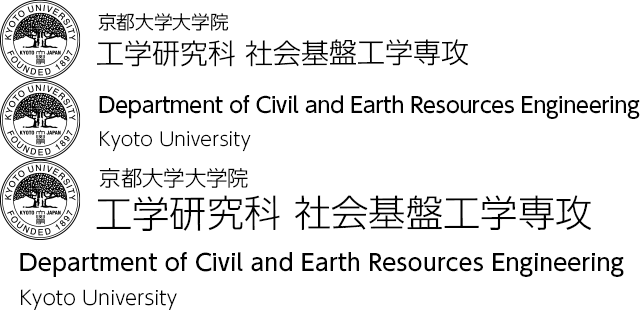Hydroscience and Hydraulic Engineering
Research fields covered by this group are most of water-caused and water-related disasters such as floodings of water and sediment, debris flows, storm surges and tsunamis. Mechanisms of these disasters and their prevention/mitigation schemes are studied both in laboratory experiments and in field observations.
Fundamental research in hydroscience and hydraulic engineering is also conducted, particularly taken recent ecological/environmental matters into account. Experiments are carried out at the Ujigawa Open Laboratory being full use of flumes, basins and hydraulic models of various sizes and scales. Computational models are also developed and utilized for better understandings and prediction of the phenomena.
Academic Staff
Kenji KAWAIKE
 Professor (Disaster Prevention Research Institute)
Professor (Disaster Prevention Research Institute)
Research Topics
Main research interest is the numerical simulation of inundation flow due to dike breach or heavy rainfall. Using the numerical simulation, the effect of flood control facilities, such as pump stations, water channels, water gates and sewerage systems, are investigated.
Contacts
Ujigawa Open Laboratory Disaster Prevention Research Institute
TEL: +81-75-611-4396
FAX: +81-75-611-4396
E-mail: kawaike.kenji.5n![]() kyoto-u.ac.jp
kyoto-u.ac.jp
Hiroshi TAKEBAYASHI
 Associate Professor (Disaster Prevention Research Institute)
Associate Professor (Disaster Prevention Research Institute)
Research Topics
Stream and bed deformation analysis method, sediment (material) runoff method and prediction method of habitat for fauna and flora have been developed by clarifying mechanism of sediment transport and bed deformation. Furthermore, the method to produce sediment transport system which has a well-balanced sediment environment for both safe for our life and eco-system has been developed by use of these methods.
Contacts
Ujigawa Open Laboratory, Disaster Prevention Research Institute
TEL: +81-75-621-2144
FAX: +81-75-621-2144
E-mail: takebayashi.hiroshi.6s![]() kyoto-u.ac.jp
kyoto-u.ac.jp
Takahiro KOSHIBA
 Assistant Professor (Disaster Prevention Research Institute)
Assistant Professor (Disaster Prevention Research Institute)
Research Topics
My research focuses around efficient and eco-friendly solutions for dam operations, this includes reservoir sedimentation and hydro abrasion issues, also I study the development of surrogate bedload monitoring systems, in relations to sediment hydraulics, signal processing and statistical modeling.
Contacts
Ujigawa Open Laboratory Disaster Prevention Research Institute
TEL: +81-75-611-4395
FAX: +81-75-611-4395
E-mail: koshiba.takahiro.4s![]() kyoto-u.ac.jp
kyoto-u.ac.jp
website:http://koshiba.sakura.ne.jp/about_me.html
Research Topics
Three dimensional structure of flood flow and bed form
Flood flow in a river has a three dimensional structure and vortex and secondary flows are observed in this flow. Study on the three dimensional structure gives basic information about problems concerning water engineering and water-related disasters, e.g. flow resistance, disaster-causing mechanisms etc.
Flows in straight channels of rectangular/trapezoidal cross-section and compound cross-section have been investigated by making full use of measuring devices like laser Doppler velocimeter, water-level meter, pressure meter and so on. Flow visualization techniques have also been used to obtain an instantaneous feature of the flow field with the aid of hydrogen bubbles, plastic beads and dye. Relation between the flow structure and bed form has been studied in a compound meandering channel and it is found that the secondary flow makes an important role in the erosion and deposition on the bed.
Recently, experiments on complex flows around constriction and groyne have been performed, the complicated structures are clarified by using the precise data obtained by velocity measurements and PIV method.
Hydraulics on inundating flow and design flooding
Recently, the comprehensive flood control measures to disperse inundation areas and minimize flood damage by flowing into design flooding areas through open dykes and fuseplug levees have been submitted. Field surveys and experimental investigations are conducted to elucidate the hydraulics on inundating flow and design flooding.
The flooding in the Yosasa river in Tochigi Prefecture on August 26, l998 that exceeded design flood is investigated on the results of field survey and experimental investigations are conducted on typical hydraulic phenomena.
On the Katsura river in Kameoka city and the Yura river in Hukuchiyama city which have the flood control measures by flowing into design flooding areas through open dykes and groves in the floodplain, the field surveys on inundation and experimental investigations are conducted. Through these studies, the role of traditional flood control measures is discussed.
Observations and experiments of sediment transport phenomena
Imbalance of sediment transport in time and space generates sediment disasters. In a mountainous area, rapid mass movements such as a debris flow, pyroclastic flow, mudflow, slope failure, and etc. occur due to heavy rainfalls, volcanic activities, earthquakes, and etc., while comparatively slow sediment transport phenomena such as sedimentation in sabo dams and reservoirs, river bank erosion, local scouring around piers, and etc. also occur, resulting in sediment disasters. Mechanisms of these sediment transport phenomena are investigated not only by the observations and physical model experiments but a[so by mathematical modeling.
Numerical simulation models are also developed in order to predict the phenomena and to establish the effective countermeasures against sediment disasters. Movable bed physical model experiments such as river course maintenance for navigation in the Yodo River have been carried out. Optimal shape of groynes and their arrangement are investigated. Methods to Delineate the sediment hazard prone area have been developed by using numerical simulation models. Efficacy of the sabo works such as sabo dams and channel works is investigated by using numerical simulation methods.
Observation and simulation on the flow mechanism in coastal region
In recent years there has been increasing interest in environmental problems in bays and coastal areas. As the basics to treat various processes occurring in those areas from physical/chemical/biological aspects, it is of great importance to clarify hydraulic behavior in these areas.In this research section, hydraulic behavior in coastal region is studied by some hydraulic and numerical models or field observations. Hydraulic model tests on the tidal currents in Bay areas have been carried out with flow visualization technique, and observational investigations on the flow mechanism have executed at the observational facilities continuously. Numerical simulation models such as driftwood motion have been developed by using Lagrangian-Eulerian coupling model in consideration of both tidal currents and wind.
Interdisciplinary hydraulics - Ecology and Hydrodynamics -
One of the most important issues in today's hydraulics lies in an interdisciplinary area between ecology and hydrodynamics. It is no doubt that we must hand all water and water-related areas in a good, or better if possible, condition over to the next generations. Now it has gradually been known that a flow field possessing "complexity"* and "variety"** provides preferable environment. However, from the viewpoint of flood defense, such a flow field may not always be accepted. It has not yet been established a balanced solution between ecological management and flood alleviation scheme. As an example of such a flow field our group pays attention to groyne fields. Flow pattern and sediment movement in groyne fields are studied both in laboratory experiments and in field observations. The obtained data not only give basic information but will lead a new solution and design prospects for such flow fields.
*complexity of geometry, flow pattern, stage variation, etc.
**variety of water depth, sediment material and size, vegetation, etc.
